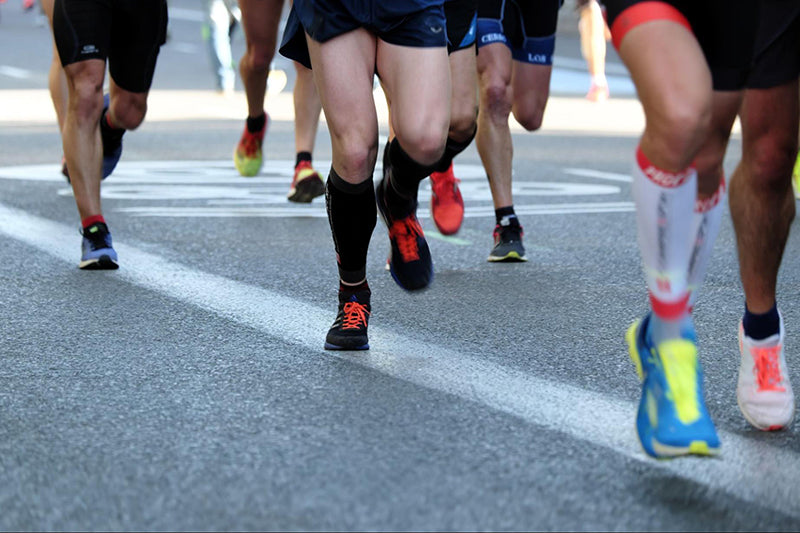For a runner, nothing is more frustrating than putting in time and energy to run a race only to be sidelined by an injury before race day. Our bodies are made to adapt to gradually increased training, but they work best when we are paying attention to good movement prep and recovery. When we don’t prepare our muscles for high impact training like endurance runs, we’re susceptible to a variety of different injuries. There’s a reason why up to 90% of runners will experience some type of running-related injury in their lifetime.
With numbers like that, the real question is, how can you set yourself up for success and make it to race day?

Running Form
Shane Benzie, known as the “Elastic Runner” was interviewed by Runner’s World and describes how many of the best runners in the world lengthen the long fascial chains of the body and “make a bow” (like bow and arrow) where your chest is slightly out, and the head reaches upward as you run.1 This allows you to create better elasticity through lengthening your fascial lines to create better recoil and adds some spring to your step and your whole body. This connection between your body’s natural tension system and running economy is what many high performing runners have adopted for better performance and making their bodies resistant to injury.

Training Pace
When you have a goal in mind, like a marathon with a set date, it’s easy to lay ambitious plans to reach your desired distance or time, but a key to making it to race day is listening to your body's unique pacing. On top of common injuries that come with increased workload, runners are especially susceptible to injury with increased training because fatigue leads to poor form which contributes to muscular and skeletal injuries that occur over time and may not be immediately painful. This could mean pushing through an aggressive training plant with an injury, worsening the effects and dragging out recovery time. Remaining realistic with your pacing and listening to your body will get you to your goal faster and help you avoid progress halting injuries.

Movement Prep and Recovery
In addition to proper form and gradual, smart training progression proper myofascial release before and after running sessions significantly reduces the risk of injury by ensuring that muscles function properly during your workout and recover quickly afterwards.
To get scientific, the running motion depends on our bodies using tension created through long fascial lines to support a kinetic chain that alternates stable body segments connected by mobile joints. In other words, to run in the most efficient way, our bodies depend on muscle groups to be elastic and hold an appropriate amount of tension to properly support the rapidly changing balance and loads that endurance running requires.
A common problem is that one area or side of your muscular system is falling short, causing repeated overstrain on the rest of your body with each step. The result is common running-related injuries such as lower limb injuries that include knee injuries, shin splints, Achilles tendinopathy, and plantar fasciitis.3
The solution is implementing a targeted warm-up routine aimed at preparing the muscle groups that will support mobility and stability during your run like the following:
-
Chest Release
The pectoral muscle group of the chest will allow you to open the chest and create that bowing position. This is the opposite shape most of us make during our day while working at a desk or looking at our smart device, so this is essential to shift your upper body posture for running. -
Lat Release
The lat muscle is attached to the inside of the upper arm and if not prepped properly can cause the shoulder to roll forward into a poor position for your arm swing during running. In addition to protecting your back, this release also helps open the chest and extend the upper back for a better running position. -
Front Hip Release
When we sit for long periods of time our hips get tight and rarely become fully extended to release negative tension which keeps your hips partially flexed and pulls the pelvis and low back into a poor position. Releasing this muscle group allows for better posture and protects your lower back from injury. -
IT Band Release
The thick connective tissue of your IT band runs from the side of your hip down to the side of your knee and provides lateral support during a run. Myofascial release can encourage replenishing fluids and blood flow that assist in warming up the tissues for better support, protecting your knees. -
Calf Release
The gastrocnemius muscles on the back of the lower leg are necessary for good ankle and knee mobility. It is important to maintain the elastic tension without locking out the range of motion needed to support the surrounding joints which is why myofascial release for this muscle group is essential for runners to protect your ankles. -
Foot Release
Commonly missed or under-prepped during warmup, your foot is your connection to the ground that leverages reaction forces to initiate the spring-like energy from the ground up. Myofascial release helps ensure that the multiple joints throughout the foot are aligned properly to transfer this energy up the chain for a better run.

Ready to run? Full tutorials for each of these releases can be found on the My Mobo app, free on the App Store or Google Play. Watch the running playlist for a full run-down of myofascial releases that can be added to your dynamic warm-up to optimize your mobility work and that will get you to the finish line!
References
-
https://www.runnersworld.com/uk/training/a35160321/what-is-fascia/
Shane: IG post on tension model and foot- https://www.instagram.com/p/B7N-LvoHumM/?utm_source=ig_web_copy_link
-Shane Benzie - #elasticrunner - Pizzuto, Federico1; de Oliveira, Camila Fonseca2,3; Soares, Tania Socorro Amorim2,3; Rago, Vincenzo2,4; Silva, Gustavo5; Oliveira, José5 Relationship Between Running Economy and Kinematic Parameters in Long-Distance Runners, Journal of Strength and Conditioning Research: July 2019 - Volume 33 - Issue 7 - p 1921-1928. doi: 10.1519/JSC.0000000000003040
- Boullosa D, Esteve-Lanao J, Casado A, Peyré-Tartaruga LA, Gomes da Rosa R, Del Coso J. Factors Affecting Training and Physical Performance in Recreational Endurance Runners. Sports. 2020; 8(3):35. https://doi.org/10.3390/sports8030035



